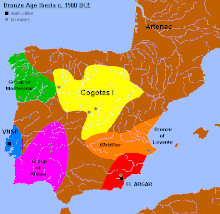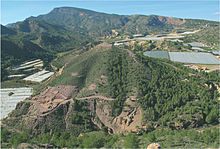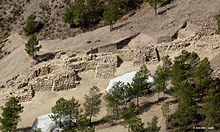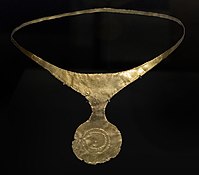 | |
| Geographical range | Southeast Spain |
|---|---|
| Period | Bronze Age |
| Dates | c. 2200 — c. 1300 BC |
| Major sites | El Argar, La Bastida de Totana |
| Preceded by | Bell Beaker culture, Millaran culture |
| Followed by | Motillas, Levantine Bronze Age, Post-Argar, Cogotas culture |
The Argaric culture, named from the type site El Argar near the town of Antas, in what is now the province of Almería in southeastern Spain, is an Early Bronze Age culture which flourished between c. 2200 BC and 1550 BC.
The Argaric culture was characterised by its early adoption of bronze, which briefly allowed this tribe local dominance over other, Copper Age peoples. El Argar also developed sophisticated pottery and ceramic techniques, which they traded with other Mediterranean tribes.
The center of this civilization is displaced to the north and its extension and influence is clearly greater than that of its ancestor. Their mining and metallurgy were quite advanced, with bronze, silver and gold being mined and worked for weapons and jewelry.
Pollen analysis in a peat deposit in the Cañada del Gitano basin high in the Sierra de Baza suggests that the Argaric exhausted precious natural resources, helping bring about its own ruin. The deciduous oak forest that covered the region's slopes were burned off, leaving a tell-tale carbon layer, and replaced by the fire-tolerant, and fire-prone, Mediterranean scrub familiar under the names garrigue and maquis.
Extension
Main Argaric towns


- El Argar: irregularly shaped (280 x 90 m).
- Fuente Vermeja: small fortified site, 3 km north of El Argar
- Lugarico Viejo: larger town very close to Fuente Vermeja.
- La Bastida de Totana: larger fortified site.

- La Almoloya (Pliego, Murcia): in the top of a plateau.
- Puntarrón Chico: in the top of a small hill, near Beniaján (Murcia)
- Ifre (Murcia): on a rocky elevation.
- Zapata (Murcia): 4 km. west of Ifre, fortified.
- Cabezo Redondo (Villena, Alicante): one of the biggest settlements, on a rocky elevation next to an old lagoon and salt evaporation pond.
- Gatas (4 km west of Mojácar, Almería): fortified town on a hill with remarkable water canalizations.
- El Oficio (9 km north of Villaricos, Almería): atop of a well defended hill, strongly fortified, especially towards the sea.
- Cerro de las Viñas, Coy, Spain
- Fuente Álamo (7 km north of Cuevas de Almazora, Almería): the citadel is atop a hill, while the houses are terraced in its southern slope.
- Almizaraque (Almería): a town dating to Los Millares civilization.
- Cerro de la Virgen de Orce (Granada).
- Cerro de la Encina (Monachil, Granada).
- Cuesta del Negro (Purullena, Granada).
- El Castellón Alto
Material culture

Glass beads
A meaningful element are the glass beads (of blue, green and white colors) that are found in this culture and which have been related with similar findings in Egypt (Amarna), Mycenaean Greece (dated in the 14th century BC), the British Wessex culture (dated c. 1400 BC) and some sites in France. Nevertheless, some of these beads are already found in chalcolithic contexts (site of La Pastora) which has brought some to speculate on an earlier date for the introduction of this material in southeast Iberia (late 3rd millennium BC).
Other manufactured goods
Pottery undergoes important changes, almost totally abandoning decoration and with new types.
Textile manufacture seems important, working specially with wool and flax. Basket-making also seems to have been important, showing greater extent and diversification than in previous periods.
Funerary customs
The collective burial tradition typical of European Megalithic culture is abandoned in favor of individual burials. The tholos is abandoned in favour of small cists, either under the homes or outside. This trend seems to come from the Eastern Mediterranean, most likely from Mycenaean Greece (skipping Sicily and Italy, where the collective burial tradition remains for some time yet).
From the Argarian civilization, these new burial customs will gradually and irregularly extend to the rest of Iberia.
In the phase B of this civilization, burial in pithoi (large jars) becomes most frequent (see: Jar-burials). Again this custom (that never reached beyond the Argarian circle) seems to come from Greece, where it was used after. ca 2000 BC.
Genetic profile
Out of 36 males tested from La Almoloya and La Bastida sites, 35 were assigned to haplogroup R1b-M269 (the exact phylogenetic position on the Y haplogroup tree could be resolved further in 14 males, who carry the derived variant at Y-SNP P312, and the derived subvariant Y-SNP Z195 in 18 males), only an individual was from another clade, E1b-L618. The Argar Culture was likely formed from a mixture of new groups arriving from north-central Iberia (which already carried the predominant Y-chromosome lineage and central European steppe-related ancestry) and local southeastern Iberian Copper Age groups that differed from other Iberian regions in that they carried an Iran Neolithic-like ancestry (similar to that found in eastern and/or central Mediterranean ancient groups). The major additional ancestry source resembled central European Bell Beaker groups, which first contributed ancestry to northern Iberia, followed by a southward spread. The distal sources were ~60% Anatolian farmer, ~25% Western Hunter-Gatherer, ~15% Yamnaya. Some phenotypìc traits were: absolute majority of brown eyes, pale skin was majoritary, and brown hair was more usual than black hair.
Gallery
-
 Grave goods
Grave goods
-
 Typical jar burial
Typical jar burial
El Argar B -
 Woman's skull
Woman's skull
with diadem -
 Bronze sword with gold-covered hilt
Bronze sword with gold-covered hilt
-
 Bronze axe and dagger blade
Bronze axe and dagger blade
-
 Ceramic cup
Ceramic cup
-
Pottery
-
 Silver diadem from La Almoloya.
Silver diadem from La Almoloya.
-
Pottery
-
Pottery
-
 Ceramics
Ceramics
-
 Ceramics
Ceramics
-
La Bastida Totana archaeological site
-
 Remains of a house at La Bastida Totana
Remains of a house at La Bastida Totana
-
 Excavation at Peñalosa
Excavation at Peñalosa
-
 Treasure of Cabezo Redondo
Treasure of Cabezo Redondo
-
 Pottery
Pottery
-
 Archer's wristguard
Archer's wristguard
-
 La Bastida de Totana wall remains
La Bastida de Totana wall remains
-
 Map of El Argar
Map of El Argar
-
 Cist burial reconstruction
Cist burial reconstruction
-
 El Argar
El Argar
Related cultures
- Los Millares: its antecessor culture.
- Bell Beaker culture: its antecessor culture.
- Bronze of Levante: extending by the Land of Valencia: with smaller towns but very related to El Argar.
- Motillas (La Mancha): what would seem a military march of these proto-Iberian peoples.
- Cogotas culture was influenced by El Argar.
- South-Western Iberian Bronze circle.
- Mycenaean Greece: some cultural exchanges across the Mediterranean are very clear, with Argarians adopting Greek funerary customs (individual burials, first in cist and then in pithos), while Greeks also import the Iberian tholos for the same purpose.
- Nuragic civilization: Cultural exchange and probably influenced the Nuragic people with their tholos.
See also
- Vila Nova de Sao Pedro
- Prehistoric Iberia
- Treasure of Villena
- Unetice culture
- Bronze Age Britain
- Bell Beaker culture
- Levantine bronze
Notes
- Lull, Vicente; R. Micó; Cristina Rihuete Herrada; Roberto Risch (2011). "El Argar and the Beginning of Class Society in the Western Mediterranean". Archäologie in Eurasien. 24: 381–414.
- Lull, Vincente; R. Micó; Cristina Rihuete Herrada; Roberto Risch (2013). Bronze Age Iberia. Oxford University Press. pp. 594–616. ISBN 9780199572861.
{{cite book}}:|journal=ignored (help) - C. Michael Hogan, Los Silillos, the Megaltihic Portal, ed. Andy Burnham
- BBC News, "Eco-ruin 'felled early society'" 15 November 2007.
- Carrión, J.S.; Fuentes, N.; González-Sampériz, P.; Quirante, L. Sánchez; Finlayson, J.C.; Fernández, S.; Andrade, A. (2007). "Holocene environmental change in a montane region of southern Europe with a long history of human settlement". Quaternary Science Reviews. 26 (11–12): 1455–1475. Bibcode:2007QSRv...26.1455C. doi:10.1016/j.quascirev.2007.03.013.
- 3D reconstruction of La Bastida de Totana (2015).
- 3D reconstruction of La Bastida de Totana (2015).
- Digital reconstruction of La Almoloya (2015).
- La Almoloya: The First Parliament of Europe (2022).
- The Bronze Age treasure that could rewrite history (2022).
- Digital reconstruction of La Almoloya (2015).
- Villalba-Mouco, Vanessa; Oliart, Camila; Rihuete-Herrada, Cristina; Childebayeva, Ainash; Rohrlach, Adam B.; Fregeiro, María Inés; Celdrán Beltrán, Eva; Velasco-Felipe, Carlos; Aron, Franziska; Himmel, Marie; Freund, Caecilia; Alt, Kurt W.; Salazar-García, Domingo C.; García Atiénzar, Gabriel; de Miguel Ibáñez, Ma. Paz; Hernández Pérez, Mauro S.; Barciela, Virginia; Romero, Alejandro; Ponce, Juana; Martínez, Andrés; Lomba, Joaquín; Soler, Jorge; Martínez, Ana Pujante; Avilés Fernández, Azucena; Haber-Uriarte, María; Roca de Togores Muñoz, Consuelo; Olalde, Iñigo; Lalueza-Fox, Carles; Reich, David; Krause, Johannes; García Sanjuán, Leonardo; Lull, Vicente; Micó, Rafael; Risch, Roberto; Haak, Wolfgang (19 November 2021). "Genomic transformation and social organization during the Copper Age–Bronze Age transition in southern Iberia". Science Advances. 7 (47): eabi7038. doi:10.1126/sciadv.abi7038. hdl:10810/54399. PMC 8597998. PMID 34788096.
- The Bronze Age treasure that could rewrite history (2022).
- 3D reconstruction of La Almoloya (2015).
Bibliography
- F. Jordá Cerdá et al. History of Spain 1: Prehistory. Gredos ed. 1986. ISBN 84-249-1015-X
External links
![]() Media related to Argaric culture at Wikimedia Commons
Media related to Argaric culture at Wikimedia Commons
- Proyecto Bastida Research into Argaric society
- Emblems and spaces of power during the Argaric Bronze Age at La Almoloya, Murcia (Lull et al. 2021)
- The Society of El Argar by the Museum of Almería
- El Argar settlement reconstruction
37°15′08″N 1°55′03″W / 37.2521°N 1.9175°W / 37.2521; -1.9175
Categories: